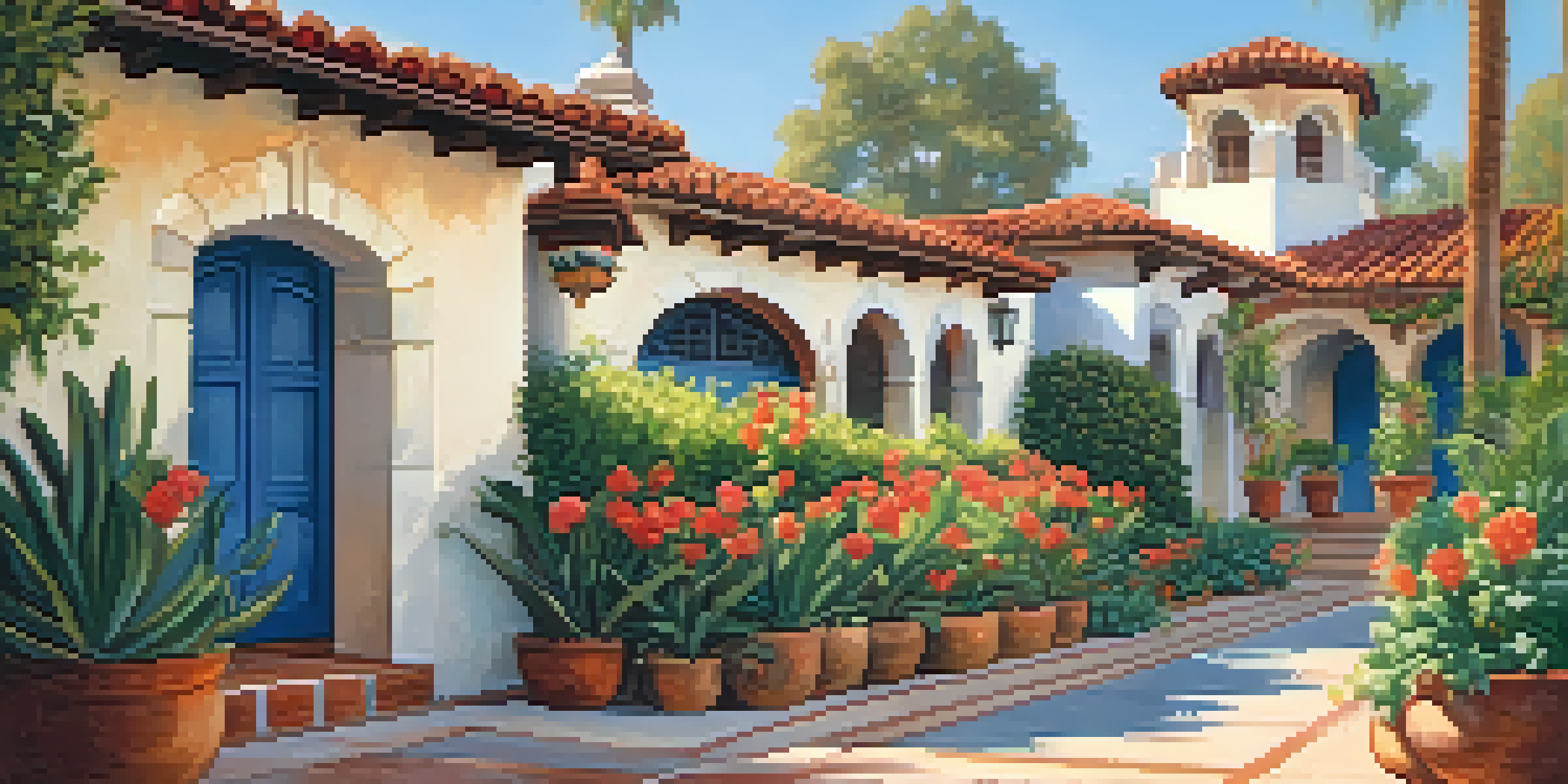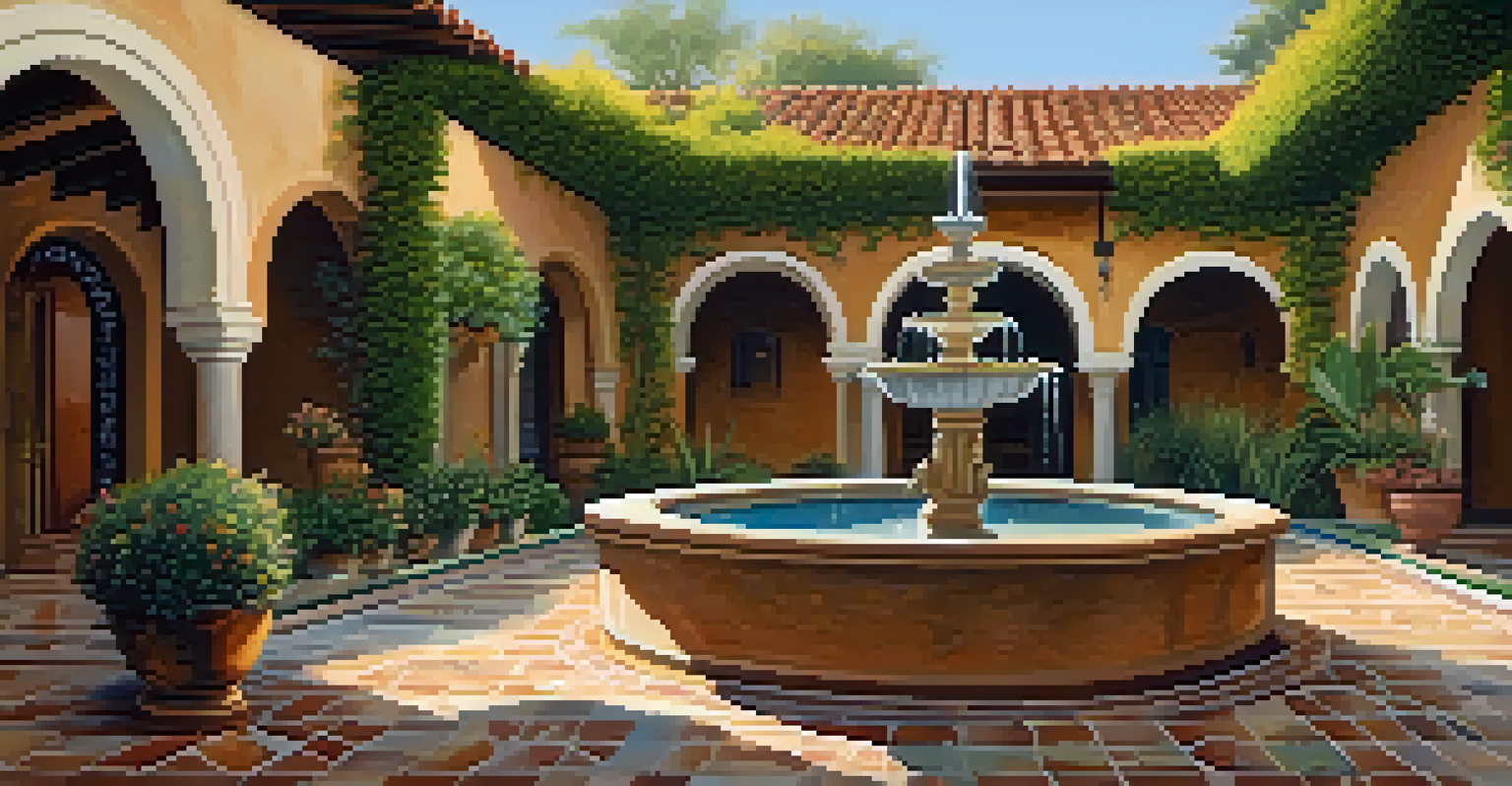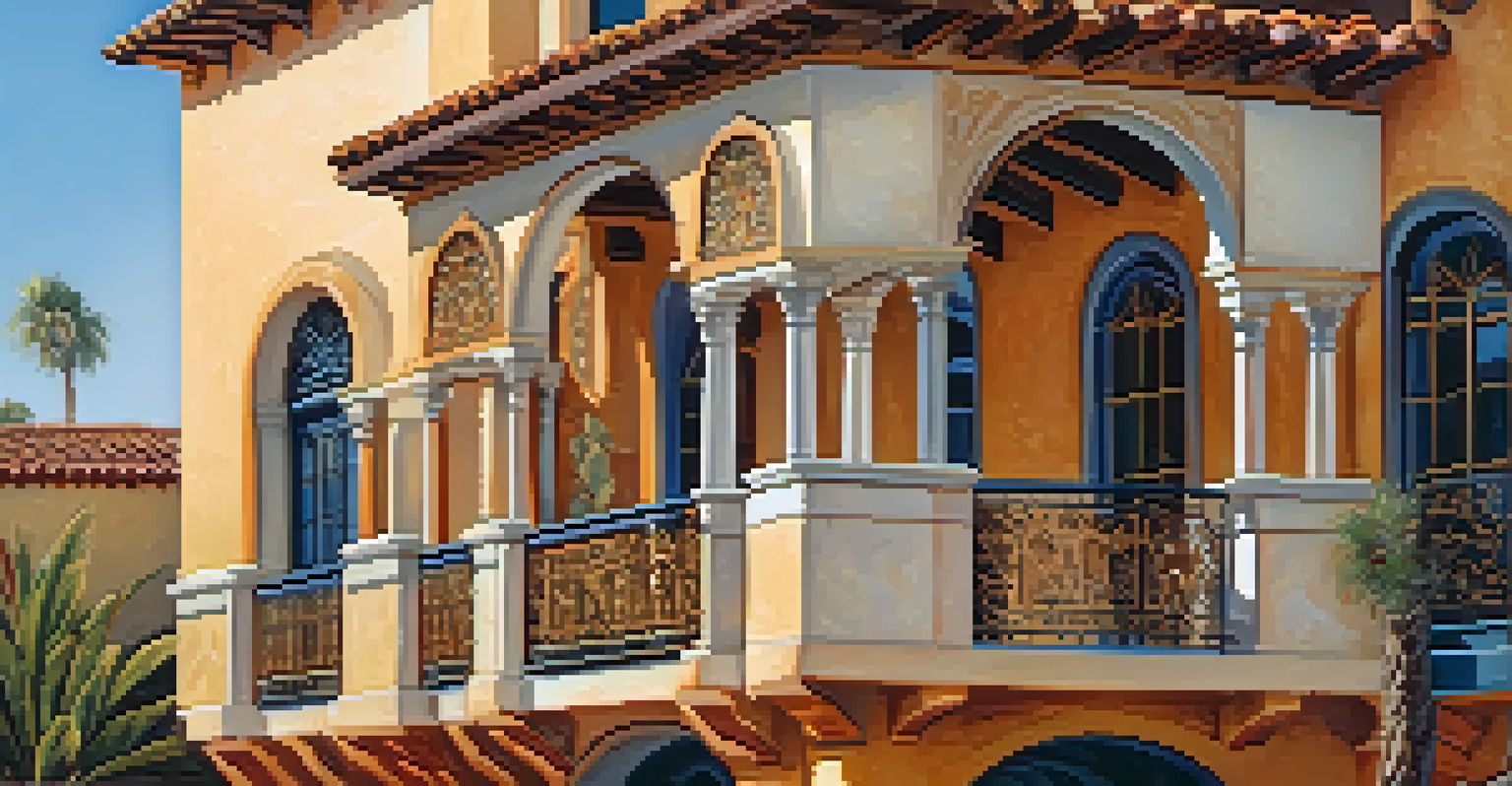Examining the Impact of Spanish Colonial Revival in LA

Understanding Spanish Colonial Revival: A Brief Overview
Spanish Colonial Revival is an architectural style that emerged in the early 20th century, primarily inspired by the colonial architecture found in Spain and Latin America. It gained traction in the United States as a way to evoke nostalgia for a romanticized past, especially in areas with a significant Hispanic heritage. In Los Angeles, this style became particularly popular during the 1920s and 1930s, reflecting both cultural pride and the city's burgeoning identity.
Architecture is the thoughtful making of space.
Characterized by its use of stucco exteriors, red-tiled roofs, and decorative tilework, Spanish Colonial Revival showcases a blend of Baroque and Moorish influences. These elements create a warm, inviting aesthetic that resonates with many Angelenos. The style was often used in residential homes, public buildings, and even commercial establishments, contributing to a cohesive visual narrative throughout the city.
This architectural movement was not just about aesthetics; it also represented a deeper cultural connection and an appreciation for the area's colonial history. As Los Angeles expanded, Spanish Colonial Revival architecture became a symbol of the city's unique identity, intertwining its past with modern developments.
Key Features of Spanish Colonial Revival Architecture
When you walk through neighborhoods adorned with Spanish Colonial Revival buildings, certain features immediately catch your eye. The style often includes arched doorways, wrought iron details, and expansive verandas, all designed to enhance both beauty and functionality. These elements create a seamless flow between indoor and outdoor spaces, perfectly suited for the Southern California climate.

Another hallmark of this architectural style is the vibrant use of color, particularly in decorative tiles and stucco finishes. Bright blues, greens, and earthy tones evoke the colors of the Mediterranean and the landscapes of Spain, making each building feel like a piece of art. Additionally, the incorporation of lush gardens and courtyards enhances the overall charm and creates serene retreats within bustling urban environments.
Cultural Roots of Spanish Revival
Spanish Colonial Revival architecture celebrates Los Angeles's Hispanic heritage and fosters community pride.
The roofs, typically covered in red clay tiles, are not only visually striking but also practical, providing excellent insulation against the sun's heat. This blend of form and function is a testament to the ingenuity of Spanish Colonial Revival design, making it a beloved choice for many homeowners and architects alike.
Influence on Los Angeles Urban Development
The Spanish Colonial Revival movement significantly influenced urban development in Los Angeles, shaping its architectural landscape in profound ways. As the city expanded in the early 20th century, planners and architects embraced this style to create a cohesive identity that resonated with the local population. This architectural choice helped define the city’s character and drew attention to its rich cultural heritage.
Preservation is a form of stewardship, an act of love for what has come before us.
Many iconic buildings, such as the Hollywood Bowl and the Los Angeles County Courthouse, exemplify the grandeur of Spanish Colonial Revival design. These structures not only served practical purposes but also became landmarks that tell the story of Los Angeles's evolution. As new developments emerged, the integration of this style into public spaces helped foster a sense of community and belonging among residents.
Moreover, the popularity of this architectural style inspired many neighborhoods to adopt similar aesthetics, leading to the creation of charming districts filled with character. Areas like Olvera Street and the historic core of downtown LA showcase the enduring appeal of Spanish Colonial Revival and its impact on the city's urban fabric.
Cultural Significance and Community Identity
The Spanish Colonial Revival style is more than just an architectural trend; it holds deep cultural significance for many Angelenos. The design is a celebration of the city’s Hispanic roots and serves as a reminder of the diverse communities that have shaped Los Angeles. This style reflects an appreciation for heritage, fostering pride among residents who identify with its historical context.
In neighborhoods where Spanish Colonial Revival architecture thrives, you’ll find a rich tapestry of cultural events and traditions that bring the community together. Festivals, art walks, and local gatherings often take place against the backdrop of these stunning buildings, reinforcing the connection between architecture and cultural identity. This synergy creates a vibrant atmosphere that enriches the lives of residents and visitors alike.
Key Features of the Style
This architectural style is characterized by stucco exteriors, red-tiled roofs, and vibrant decorative elements.
Furthermore, the preservation of Spanish Colonial Revival buildings has become a collective effort among communities. Many residents are dedicated to maintaining these historical structures, recognizing their value as cultural artifacts that tell the story of Los Angeles's past. This commitment to preservation ensures that future generations will continue to appreciate the beauty and significance of this architectural style.
Contemporary Interpretations of Spanish Colonial Revival
While the original Spanish Colonial Revival style flourished in the early 20th century, its influence can still be seen in contemporary architecture today. Modern architects often draw inspiration from this style, incorporating its key elements into new designs that resonate with today’s sensibilities. This blend of old and new allows for a fresh interpretation of a classic style while honoring its cultural roots.
Contemporary adaptations may include more sustainable materials and innovative technologies, reflecting the current focus on environmental consciousness. By merging traditional aesthetics with modern building practices, architects create spaces that are both functional and visually appealing. This approach not only respects the past but also meets the needs of a changing society.
Moreover, these modern interpretations help keep the spirit of Spanish Colonial Revival alive in Los Angeles. As neighborhoods evolve, the integration of this architectural style ensures that the city’s cultural narrative remains vibrant and relevant, allowing residents to connect with their heritage while embracing the future.
Challenges in Preserving Spanish Colonial Revival Buildings
Despite the beauty and cultural significance of Spanish Colonial Revival architecture, preserving these buildings presents unique challenges. Many structures face the threat of demolition due to urban development pressures, as cities evolve and land becomes more valuable. This often leads to a clash between modernization and the desire to maintain historical integrity, raising important questions about urban planning and heritage conservation.
Moreover, the costs associated with restoration can be prohibitive for some property owners. Maintaining the distinct features of Spanish Colonial Revival, such as intricate tile work or authentic materials, often requires specialized skills that aren’t always readily available. This can make preservation efforts daunting, particularly for smaller, community-driven projects.
Challenges in Preservation Efforts
Preserving Spanish Colonial Revival buildings faces challenges from urban development pressures and restoration costs.
However, many advocacy groups and local organizations are dedicated to raising awareness about the importance of preserving these architectural gems. Through education, fundraising, and community engagement, they work to ensure that the legacy of Spanish Colonial Revival continues to be celebrated in Los Angeles, encouraging a sense of responsibility toward architectural conservation.
The Future of Spanish Colonial Revival in Los Angeles
As Los Angeles continues to grow and change, the future of Spanish Colonial Revival architecture remains a topic of interest and debate. Many believe that this style will continue to play a significant role in shaping the city’s identity, particularly as younger generations seek to connect with their cultural heritage. The enduring charm of these buildings resonates with a desire for authenticity in an increasingly modern world.
With a renewed focus on sustainability and community-oriented design, architects and developers are looking for ways to incorporate elements of Spanish Colonial Revival into new projects. This could mean creating mixed-use spaces that honor the architectural style while providing modern amenities for residents and businesses. Such initiatives could breathe new life into neighborhoods while preserving their historical significance.

Ultimately, the future of Spanish Colonial Revival in Los Angeles lies in the hands of its residents and stakeholders. By fostering a culture of appreciation for this architectural style, the community can ensure that its legacy endures, enriching the lives of those who call the city home for generations to come.